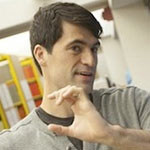Seminars are held at 1:00 PM
in the Tech F160 (2145 Sheridan Rd.) unless otherwise noted
Spring Quarter 2014
| Date | Speaker / Seminar | ||
| May 2 |  |
Blakesley Burkhart The current paradigm of the ISM is that it is a multiphase turbulent environment, with turbulence affecting many important processes. For the ISM this includes star formation, cosmic ray acceleration, and the evolution of structure in the diffuse ISM. This makes it important to study interstellar turbulence using the strengths of numerical studies combined with observational studies. I shall discuss progress that has been made in the development of new techniques for comparing observational data with numerical MHD simulations in the molecular medium, in neutral gas as traced by HI, and warm ionized gas as traced by synchrotron polarization. |
Giles Novak |
| May 9 *1:30pm |
 |
David Kipping Asterodensity Profiling (AP) is a relatively new technique in the study of transiting extrasolar planets, with the ability to aid observers in vetting and characterizing such worlds. Using Kepler's Third Law and simple geometry, it has long been known that the shape of a planet's transit light curve reveals the mean density of the host star, under various idealized assumptions such as a circular orbit. Comparing this density to some independent measure allows one to test if the assumptions hold and ultimately extract useful information about the system. I will discuss the various effects which are expected to cause AP deviations aside from non-circularity, providing their magnitude and direction in each case. These techniques may be applied to the Kepler data set, using asteroseismically inferred stellar densities as the independent density measure. Focussing on the single transiting planet candidate systems, I present an AP survey on all 41 candidates associated with 31 dwarf stars and 10 giant stars. These results indicate a high false positive rate for the giant star sample, whilst the dwarfs are consistent with a low false positive rate and the expected distribution due to eccentricity. Finally, I will discuss a new method for expanding AP to thousands of stars, rather than the few hundred with asteroseismology. By measuring the brightness variations of a star over 8 hours, the "flicker", I'll demonstrate that the stellar density can be inferred to ~30% precision down to 14th magnitude with Kepler. Invoking flicker will not only extend AP's reach in the Kepler sample, but also for the upcoming TESS and PLATO missions. AP therefore has a bright future in vetting planetary candidates and extracting the eccentricity distribution of various sub-populations, all using photometry alone. |
Jason Steffen |
Fall Quarter 2013
| Date | Speaker / Seminar | ||
| Oct. 18 |  |
Benjamin Oppenheimer The recent efforts to observe the circumgalactic halo gas surrounding galaxies have uncovered significant reservoirs of baryons and metals. UV absorption line spectroscopic surveys have revealed highly ionized metals indicating that galaxies likely eject large fractions of their stars’ nucleosynthetic yields out to hundreds of kpc. I will discuss how the patterns of enrichment around galaxies similar to our present-day Milky Way relate to the dynamic history of continual enrichment over the last 13 Gyrs. By running cosmological hydrodynamic simulations with self-consistent star formation, metal production from stellar evolution, and physically motivated galactic superwinds, we find the circumgalactic medium (CGM) is enriched in an outside-in fashion, and each metal ion tracing a different layer of enrichment. For example, highly ionized O VI observed at z~0.2 at 50-150 kpc traces ancient metals, often released before z=2, while Mg II absorbers trace re-accreting metal-enriched gas feeding further star formation at <50 kpc. I will relate the hydrodynamic simulation findings with the most recent observations from the COS-Halos team. The final part of the talk will be a re-examination of the CGM under the influence of fluctuating radiation from a local AGN, e.g. a Seyfert, leaving metals ionized and out-of-equilibrium in the CGM. These previously unconsidered models open a whole new range of ionization solutions that have never been considered before. Fluctuating AGN may provide a new interpretation of CGM observations, and possible clues as to how the central engines of AGN evolve and grow. |
Claude-André Faucher-Giguère |
| Nov. 15 |  |
Sijing Shen How gas is accreted into galactic halos from the intergalactic medium, processed in galaxies and ejected back to the environment are crucial questions in understanding galaxy formation and evolution. Studies of the spacial distribution, chemical composition, kinematics and ionization states of the gas within several hundreds kpc -- the circumgalactic medium (CGM) -- provide clues to understanding the cycle of baryons. In this talk, I will present a study of the co-evolution of the galaxy-CGM ecosystem using two suites of cosmological, hydrodynamic simulations from Milky Way-like scale to dwarf galaxies. The simulations adopt a blastwave scheme for supernova feedback that produce large-scale galactic outflows, metal-dependent radiative cooling, and a model for the turbulent mixing of metals. I will discuss the complex origins of the enriched CGM around massive galaxies at z ~ 3, and identify the relative contributions from the central galaxy and its accreting satellites. I will then present a detailed comparison with absorption-line studies on the distribution, kinematics and evolution of neutral hydrogen (H I) and various metal ions (Si II, Si IV, C II, C IV, Mg II and O VI) in the CGM around galaxies. We find that the CGM around massive galaxies exhibits highly multi-phase structures with kinematically aligned high and low-ionization metal absorbers. The absorption strength as a function of the the impact parameter is in good agreement with observations for all ions. The cold accretion flows probed by Lyman-limit systems (LLSs) can be enriched substantially from dwarf satellites and re-accreted outflows, making them detectable using low ionization metal species (such as MgII). If time permits, I will also discuss how these observed CGM properties depend on stellar feedback, radiative cooling and the mixing of metals. |
Claude-André Faucher-Giguère |
Dec. 13 |
 |
Robyn Sanderson The distribution of dark matter in our Galaxy is an important constraint on theories of dark matter and structure formation, yet currently is very poorly understood. The Gaia astrometric space mission, which launches this winter, will make huge strides in understanding the distribution of mass in our Galaxy by precisely measuring the six-dimensional phase space positions of 150 million stars. In this talk I show how Gaia observations of stars in the tidal streams of the accreted Galactic halo can be used to infer the halo's total gravitational potential, by exploiting the natural clustering of stream stars in action space. Tests with a spherical mock halo show that for a Gaia-like selection function and error model, the number of streams we expect to find in the accreted halo is well above the number needed to determine the two parameters of this toy potential. I will discuss the expansion of the technique to more realistic models of the potential, and the prospects given improvements in data quality from complementary ground-based surveys like LSST and WEAVE. |
Fred Rasio |
Past Theoretical Astrophysics Seminars